
Desk-and-bookcase, Boston, 1735-1740. Courbaril, red cedar, and cherry with white pine, cherry and oak. H. 97", W. 40 5/16, D. 24 1/8". Milwaukee Art Museum purchase through bequest of Mary Jane Rayniak in memory of Mr. and Mrs. Joseph Rayniak, acc. M1983.378; photo, Richard Cheek.) The scrollboard appliqué, finals, brass, and glass door plates are restored.

Interior of the desk-and-bookcase illustrated in fig. 1. (Photo, Richard Cheek.) The door panels and large scrolled vertical dividers of the bookcase and the prospect door of the desk interior are restored.

Detail of the interlocking drawers and prospect box of the desk- and- bookcase illustrated in fig. 2 (Photo, Milwaukee Art Museum.) The lock on the prospect door of the bookcase controls access to eight smaller drawers. When this door is open, a wooden spring lock releases the fascia drawer above and sliding wooden bolts let into the underside of the shelf release the two Doric column document drawers. These interlock with drawers above and below. The prospect section of the desk is held with two wooden spring locks. It houses two secret document drawers and originally concealed a secret compartment faced by a hinged false backboard.

Diagram of (a) base-molding and fallboard support construction of the desk-and-bookcase illustrated in fig. 1; (b) base-molding construction of the desk-and-bookcase illustrated in fig. 5. The shaded areas on the front of the bottom board in b represent the patches resulting from layout or construction error. (Drawing by Alan Miller; artwork, Bradley K. Szollose, K2 Design.)

Desk-and-bookcase, signed by Job Coit and Job Coit, Jr., Boston, dated 1738. Black walnut with white pine. H. 99 1/2", W. 39 5/8", D. 24 3/8". (Courtesy, Winterthur Museum, acc. 62.87.)

Desk, Boston, dated 1739. Possibly walnut, secondary wood undetermined. H. 41 1/2", W. 37 1/2", D. 21 1/2". (Lot 1349, The Jacob Paxon Temple Collection of Early American Furniture, Anderson Galleries, 1922.)

Desk-and-bookcase with carving possibly by John Welch, Boston, 1733-1738. Mahogany with oak and white pine. H. 94", W 41 1/4", D. 24". (Photo, Joe Kindig, III.) The left finial is original, and the original center finial is shown on the right corner. The finial in the center is incorrect. The top central portion of the scrollboard and a small piece of carving at the top of the appliquÈ are missing. The mirrors and backing panels, hardware, and feet are replaced. The bottom of the desk section had no evidence of bracket feet.

Desk-and-bookcase, unknown artist , Boston, MA, 1740-1750; illustrated in fig. 7. (Art Institute of Chicago, major acquisitions Centennial Fund, acc. 1986.414; digital file, ©The Art Institute of Chicago. All rights reserved.)

Detail of the scrollboard applique and center finial of the desk-and-bookcase illustrated in figs. 7, 8. (Courtesy of Sack Heritage Group)
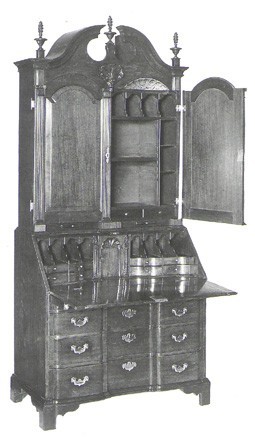
Desk-and-bookcase with carving attributed to John 'Welch, Boston, 1740-1760. woods and dimensions not recorded. (Courtesy, Bernard & S. Dean Levy, Inc., N.Y.C.)

Detail of the applique and painted gilt shells of the bookcase illustrated in fig. 10.

Detail of the applied shell and upper rail of a picture frame carved by John Welch for John Singleton Copley's portrait of Nicholas Boylston, Boston, ca. 1767. White pine, gilded. 66 3/4" x 47 3/8". (Courtesy of the Harvard University Portrait Collection, bequest of Ward Nicholas Boylston to Harvard College, 1828, ©President and Fellows of Harvard College, acc. 1828 H 90.)

Detail of Paul Revere's The Bloody Massacre Perpetuated in King Street Boston on March 5th 1770. Colored engraving on paper. 9 5/8" x 8 5/8". (Chipstone Foundation, ace. 1969.1; photo, Gavin Ash-worth.) This engraving shows the lion and the unicorn carved by Welch.
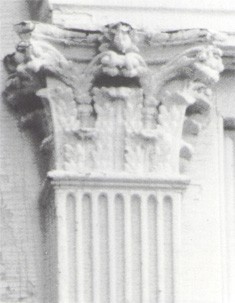
Detail of a Corinthian capital carved by John Welch for the State House illustrated in fig. 13. (Photo, Luke Beckerdite.)

Desk-and-bookcase with carving attributed to John Welch, Boston, 1743—1748. Mahogany with sabicu, red cedar, and white pine. H. 97 1/4", W. 42 3/8", D. 23 1/4". (Courtesy, Winterthur Museum, acc. 60.1134.) One Corinthian capital, part of one rosette, and the extreme side elements of the scrollboard appliquÈ are restored. A hand drawn cartouche, illegible writing, and what may be the date 1746 is on a backboard of the prospect section of the desk. the desk also has a nineteenth-century inscription, "This desk was purchased by Josiah Quince Braintree 1778."

Open view of the desk-and-bookcase illustrated in fig. 15. (Photo, Winterthur Museum.)

Detail of Corinthian capital from the desk-and-bookcase illustrated in fig. 15. (Photo, Winterthur Museum.)

Detail of the appliqué on the desk-and-bookcase illustrated in fig. 15. (Photo, Winterthur Museum.)

Detail of the left front foot of the desk-and-bookcase illustrated in fig. 15. (Photo, Winterthur Museum.)

Desk-and-bookcase with carving attributed to John Welch, Boston, ca. 1751. Mahogany with white pine. H. 97", W. 40 1/2". (38" case), D. 23" (21 1/4"case). (Chipstone Foundation, acc. 1991.6; photo, Gavin Ashworth.) The brasses and molded faces of the fallboard supports are restored.

Detail of the right pilaster and gadrooned ball foot of the desk-and-bookcase illustrated in fig. 20. (Photo, Gavin Ashworth.)

Open view, of the desk-and-bookcase illustrated in fig. 20. (Photo, Gavin Ashworth.) The carved appliques on the fascia above the prospect door are restorations based on the spandrel appliques of the clock case illustrated in figs. 27, 30.

Detail of the finials, rosette, applique, painted gilt shell, and Corinthian capital of the bookcase illustrated in figure 20. (Photo, Gavin Ashworth.)

Detail of the back of the prospect box of the desk-and-bookcase illustrated in fig. 20. (Photo, Gavin Ashworth.)
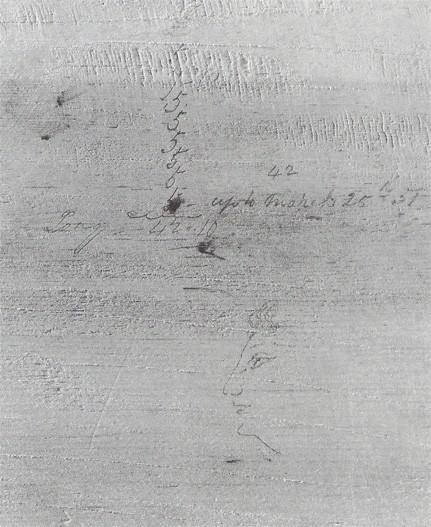
Detail of the inscription and drawing on the side of a document drawer from the prospect box illustrated in fig. 24. (Photo, Gavin Ashworth.)


Tall case clock labeled by George Glinn, with carving attributed to John Welch, Boston, 1750. H. 100". (Digital file © The Art Institute of Chicago, All rights reserved. Alyce and Edwin DeCosta and Walter E. Heller Foundation and Harold Stuart endowments, acc. 1990.395 photo, Sotheby's.) The case houses a movement by London clockmaker Thomas Hughes. The capitals of the waist pilasters and the center finial and plinth are missing.

Detail of the hood of the clock case illustrated in fig. 27. (Digital file, ©The Art Institute of Chicago. All rights reserved.)
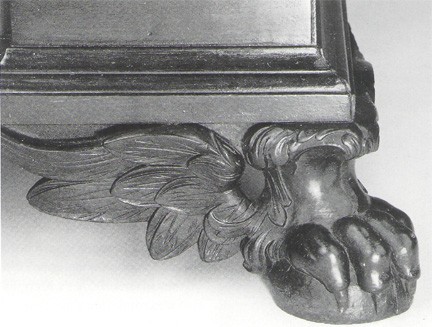
Detail of the right foot of the clock case illustrated in fig. 27. (Digital file, ©The Art Institute of Chicago. All rights reserved.)

Detail of the right spandrel appliqué of the clock case illustrated in fig. 27. (Digital file, ©The Art Institute of Chicago. All rights reserved.)

Plate 21 in Daniel Marot's Nouveau Livre d'Ornements (ca. 1703). (Dumbarton Oaks, Trustees for Harvard University.)

Tall case clock with carving attributed to John Welch, Boston, 1751-1754. Mahogany with mahogany and white pine. H. 96", W. 21 3/4", D. 11". (Chipstone Foundation, acc. 1992.12; photo, Gavin Ashworth.) The case houses a movement by London clockmaker Marmaduke Storr. The sarcophagus top and finials are missing, and the original arch fret and spandrels are replaced with burl veneer.

Detail of the base of the tall case clock illustrated in fig. 32. (Photo, Gavin Ashworth.)

Detail of the hood of the tall case clock illustrated in fig. 32. (Photo, Gavin Ashworth.)

Detail of the left Corinthian capital of the tall case clock illustrated in fig. 32. (Photo, Gavin Ashworth.)

Tall case clock with movement by Samuel Bagnall, Boston, 1740-1745. Mahogany. H. 93", W. 18 1/2". (Courtesy of Sack Heritage Group) The sarcophagus top is restored.

Tall case clock with movement by Samuel Bagnall, Boston, 1740-1745. Mahogany with white pine. H. 100 1/2", W. 21 3/8", D. 11". (Private collection; photo, LeVan Design.)

Detail of the hood and face of the movement of the tall case clock illustrated in fig. 37. (Photo, LeVan Design.) The finials, outer plinths, and upper concave element of the sarcophagus top are restored. The arch fret is a restoration based on surviving sections of the original frieze fret.

Tall case clock, Boston, 1745-1755. White pine. H. 94 1/2", W. 22 1/4", D. 10 3/4". (Courtesy, Winterthur Museum, acc. 55.96.3.) The Gawen Brown movement, finials, and arch fret of the hood are replaced. The original center plinth, scrolled brackets, and finial of the top are missing.

Desk-and-bookcase with carving attributed to John Welch, Boston, 1750-1754. Mahogany with white pine and red cedar. H. 94 1/2", W . 41 3/4", D. 22 3/4". Photo of p. 118 in the 1902 ed. of Francis Clary Morse's Furniture of the Olden Time.)

Detail of the desk-and-bookcase illustrated in fig. 40.

Detail of the right front foot of the desk-and-bookcase illustrated in fig. 40. (Private collection; photo, Brock Jobe.)
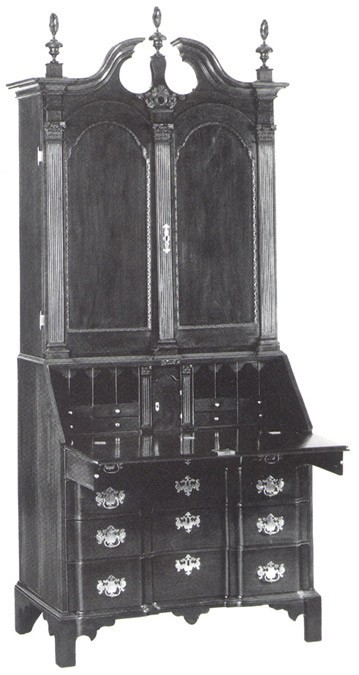
Desk-and-bookcase with carving attributed to John Welch, Boston, 1751-1756. Mahogany with white pine. H. 95 1/2", W. 40", D. 22". (The Saint Louis Art Museum, Museum Shop Fund, acc. 84:1989; photo, Christie's.) The scrollboard is cut, and the roof and back boards of the head are missing. The original upper portion of the scroll moldings and scrollboard were reattached except for the center portion. The lower portions of the feet are restored and wood panels replace the original mirrors.

Detail of center finial, scrollboard applique, center capital, and carved molding of the desk-and-bookcase illustrated in fig. 43. (The Saint Louis Art Museum, Museum Shop Fund, acc. 84:1989; photo, Christie's.)

Desk-and-bookcase with carving attributed to John Welch, Boston, 1751-1756. Mahogany with white pine. H. 97 1/2", W. 45", D. 23". (The Museum of Fine Arts, Houston, Bayou Bend Collection, gift of Miss Ima Hogg, acc. B.69.363.) The feet, base molding, finial, drawers, and possibly the appliqué are restored.

Detail of the desk interior of the desk-and-bookcase illustrated in fig. 45.

Detail of the pediment and carved shells of the desk-and-bookcase illustrated in fig. 45.

Desk-and-bookcase signed Benjamin Frothingham, Boston, 1753. Mahogany with red cedar, cedrela, and white pine. H. 98 1/4", W. 44 1/2", D. 24 3/4". (Diplomatic Reception Rooms, U.S. Department of State, acc. 70.94; photo, Will Brown.) The mid-molding and finials are restored.

Interior of the desk-and-bookcase illustrated in fig. 48.

Desk-and-bookcase with caning possibly by John Welch, Boston, 1750-1756. Mahogany with white pine and oak. Dimensions not recorded. (Photo of an illustration on page 135 of the 1917 ed. of Francis Clary Morse's Furniture of the Olden Time.)

Card table with carving attributed to John Welch, Boston, 1745-1755. (Private collection; photo, courtesy, John Walton Antiques.)

Detail of the knee of the card table illustrated in fig. 51. (Photo, John Walton Antiques.)
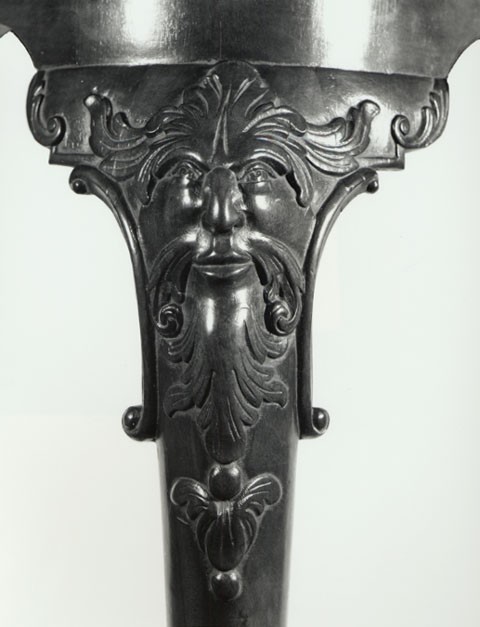
Detail of the mask knee of a pier table, carving attributed to John Welch, Boston, 1745-1760. Mahogany, H. 29", W. 28 1/2", D. 17 1/8". (Courtesy, Museum of Fine Arts, Boston, The M. and M. Karolick Collection of Eighteenth Century American Arts, acc. 41.586. Reproduced with permission. © 2000 Museum of Fine Arts, Boston. All rights reserved.)

Desk-and-bookcase, Boston, 1738—1748. Black walnut with white pine. H. 98", W. 41 1/2". (Parke-Bernet Galleries, Inc., Important XVIII Century American Furniture From the Collection of Maurice Rubin, Brookline, Mass., October 9,1954, lot. no. 174.) The gilt Corinthian capitals, festooned rosettes, and finials are above a cut line about four inches from the top of the scroll moldings.

Desk-and-bookcase, Boston, 1738—1748. Mahogany with white pine. H. 94", W. 40 1/2", D. 22". (Courtesy, Bernard & S. Dean Levy, Inc., N.Y.C.) The feet and everything above the bookcase doors are restored.
